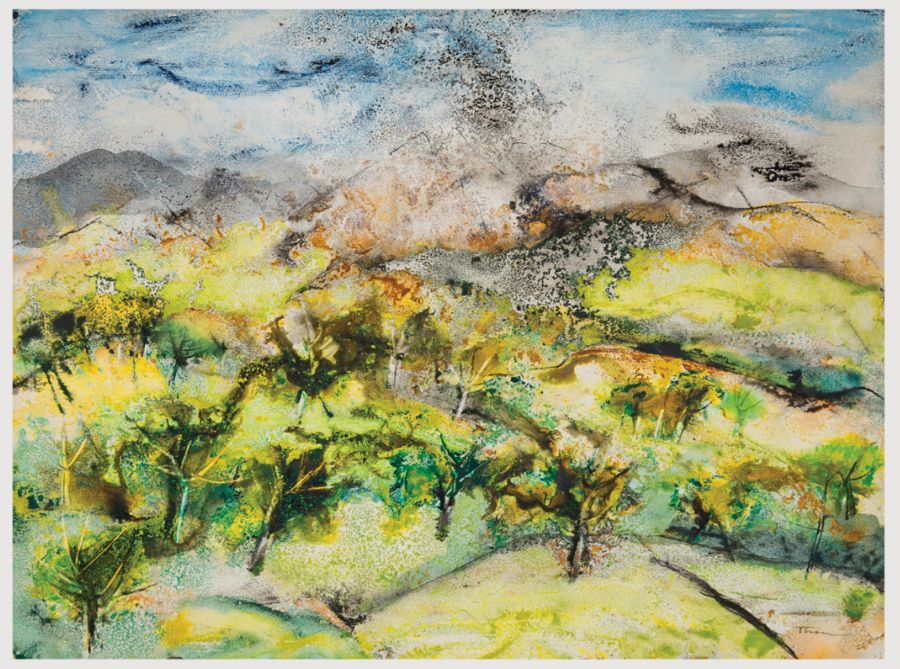Two-sided watercolor. Signed, lower right; titled verso.
Image size 20 1/2 x 27 inches (521 x 686 mm).
A fine, expressionist work, with fresh colors, on cream watercolor paper; the image extending to the sheet edges, in excellent condition.Provenance: Estate of the Artist.
"Rather than working a watercolor rapidly, the mid-twentieth-century landscape watercolorist William Thon tended to devote numerous sessions of work to each sheet, always painting indoors, where he could best control the drying rates of washes and ink drawings. As a result, Thon’s watercolors have denser, more built-up surfaces than the modernist watercolors of the teens and twenties. Thon particularly liked the interplay of the successive layers of wash and ink and the fortuitous blurring that often occurred."
—Brooklyn Museum
ABOUT THE ARTIST
William Thon (1906-2000) was noted for his highly abstracted landscape images. He was born in New York City and spent his childhood summers camping on Staten Island. He developed a great love of travel, and in 1933 made an eight-month voyage to Cocos Islands in the Pacific.
Thon debuted as a professional artist in the 1939 Corcoran Gallery Biennial exhibition. He joined the Navy during World War II, and shortly after the war won the Prix de Rome, a fellowship in Rome to the American Academy, for which he later served as a trustee. He received further recognition with his participation in the 1942 'Artists for Victory' exhibit at the Metropolitan Museum of Art. In 1944, Midtown Galleries in New York held his first one-person show—the gallery continued to represent him throughout his career. He had subsequent solo exhibitions at Smith College Art Museum, Fort Wayne Museum, and Farnsworth Museum in Rockland, Maine.
Thon received an honorary Doctor of Arts from Bates College in Lewiston, Maine, in 1957. He was a member of The American Academy and Institute of Arts and Letters and the National Academy of Design. In 1947, Thon’s year-long study at the American Academy proved pivotal in his career, when he began working in watercolor. Upon returning to America, he submitted a watercolor to the 1949 exhibition of the National Academy of Design, and that year was voted into Academy membership. He frequently exhibited at the Academy and won prizes, including the Benjamin Altman Prize in 1951, 1954, 1961, 1967, and 1969.
In 1951, Thon received a grant from the American Academy of Arts and Letters. He often traveled to Italy, and in 1955 served in Rome as Artist-in-Residence at the American Academy.
Thon chose to live in the relative isolation of Port Clyde, Maine, on a peninsula overlooking the sea, a quiet place, especially in winter. He preferred the company of sailors, craftsmen, lobstermen, a few fellow artists, and his beloved wife, Helen. This area is credited as inspiring a stylistic breakthrough for Thon when he discovered an abandoned quarry near his property. There he created numerous, increasingly abstract paintings of spidery trees with rectilinear slabs of interspersed granite. His works bore the imprint of his vital connection to the raw, natural beauty of rural Maine, its rugged terrain, beautiful virgin forests, intemperate seas, and the human made scatter of wooden buildings along its rocky shoreline.
William Thon was awarded numerous prizes and is represented in over 60 museum collections including, Metropolitan Museum of Art, Brooklyn Museum, Hirshhorn Museum, The Butler Institute of American Art, Columbus Museum of Art, and in Maine, Farnsworth Art Museum, Portland Museum of Art, and Ogunquit Museum of Art.



